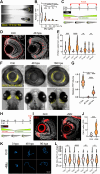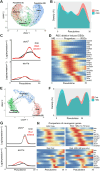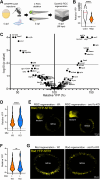A large-scale CRISPR screen reveals context-specific genetic regulation of retinal ganglion cell regeneration
- PMID: 39007397
- PMCID: PMC11361637
- DOI: 10.1242/dev.202754
A large-scale CRISPR screen reveals context-specific genetic regulation of retinal ganglion cell regeneration
Abstract
Many genes are known to regulate retinal regeneration after widespread tissue damage. Conversely, genes controlling regeneration after limited cell loss, as per degenerative diseases, are undefined. As stem/progenitor cell responses scale to injury levels, understanding how the extent and specificity of cell loss impact regenerative processes is important. Here, transgenic zebrafish enabling selective retinal ganglion cell (RGC) ablation were used to identify genes that regulate RGC regeneration. A single cell multiomics-informed screen of 100 genes identified seven knockouts that inhibited and 11 that promoted RGC regeneration. Surprisingly, 35 out of 36 genes known and/or implicated as being required for regeneration after widespread retinal damage were not required for RGC regeneration. The loss of seven even enhanced regeneration kinetics, including the proneural factors neurog1, olig2 and ascl1a. Mechanistic analyses revealed that ascl1a disruption increased the propensity of progenitor cells to produce RGCs, i.e. increased 'fate bias'. These data demonstrate plasticity in the mechanism through which Müller glia convert to a stem-like state and context specificity in how genes function during regeneration. Increased understanding of how the regeneration of disease-relevant cell types is specifically controlled will support the development of disease-tailored regenerative therapeutics.
Keywords: Ascl1; CRISPR screen; Neural stem cell; Regeneration; Retina.
© 2024. Published by The Company of Biologists Ltd.
Conflict of interest statement
Competing interests J.S.M. holds patents for the NTR inducible cell ablation system (US 7,514,595) and uses thereof (US 8,071,838 and US 8431768).
Figures





References
-
- Amador-Arjona, A., Cimadamore, F., Huang, C.-T., Wright, R., Lewis, S., Gage, F. H. and Terskikh, A. V. (2015). SOX2 primes the epigenetic landscape in neural precursors enabling proper gene activation during hippocampal neurogenesis. Proc. Natl. Acad. Sci. USA 112, E1936-E1945. 10.1073/pnas.1421480112 - DOI - PMC - PubMed
MeSH terms
Substances
Grants and funding
- G2020315/BrightFocus Foundation
- OIA-2242771/National Science Foundation
- T32 GM136577/GM/NIGMS NIH HHS/United States
- T32 GM133369/GM/NIGMS NIH HHS/United States
- F31EY032790/NH/NIH HHS/United States
- G2020315/Brightfocus Foundation
- R01 EY031685/EY/NEI NIH HHS/United States
- R01 EY022810/EY/NEI NIH HHS/United States
- T32 EY007143/EY/NEI NIH HHS/United States
- EY032790-01/NH/NIH HHS/United States
- OIA2242771/U.S. National Science Foundation
- F31 EY032790/EY/NEI NIH HHS/United States
- P20 GM144230/GM/NIGMS NIH HHS/United States
- P30 EY001765/EY/NEI NIH HHS/United States
- R01 OD020376/OD/NIH HHS/United States
- R01 EY036173/EY/NEI NIH HHS/United States
- R01 EY033009/EY/NEI NIH HHS/United States
- Johns Hopkins University School of Medicine
LinkOut - more resources
Full Text Sources
Molecular Biology Databases
Research Materials

